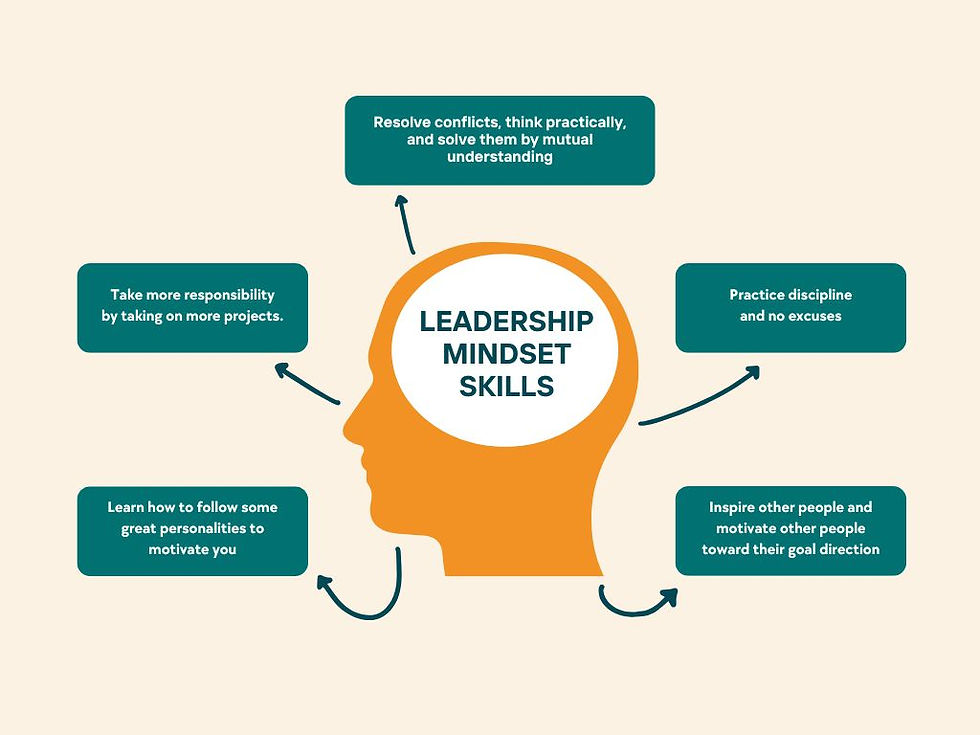EDEL 6113: Transformational leadership with the Education System
- Brianne Matthews
- May 15
- 8 min read
Updated: May 16
Introduction
Leadership is one of several aspects that are critical in helping an organization achieve its objectives. The role of leadership is to accomplish its goals within the organization with the available resources. Examples of such leaders include the Chief Executive Officer (CEO) and other members of their senior management. To reiterate, the use of these leadership styles depends on the company’s culture and operational philosophy. Several different leadership styles may be used depending on the company's culture and operational philosophy. It's important to note that the focus of this study is only on the educational world's transformational leadership style. This study will also look at the status of educational, transformational leadership theory.
Transformational Leadership
Transformational leadership leads to motivating, encouraging and inspiring workers to innovate and develop new ideas via continuous research that may assist the organization in accomplishing its objectives. It is used (including both short term as well as long term). Employee ownership and independence foster in the workplace, which improves the employee's ability to perform and commitment to the company (Korejan & Shahbazi, 2016). To assume power and make choices for their given duties, transformational leaders identify the organization's capable and efficient workers. Rather than just motivating workers, transformational leaders coach and educate them to become transformational leaders themselves. The following traits characterize transformational leadership:
It increases employee motivation and fosters a feeling of progress among them.
It motivates others to uphold high standards of ethical and moral conduct.
The atmosphere makes it more communicative & cooperative, with an emphasis placed upon authenticity in work.
As a result, leaders are those rare individuals who can motivate and inspire others to greatness. As a result, we may argue that transformational leadership includes bringing about change and that leaders are change agents. The idea of transformational leadership makes the premise that leaders have a greater propensity for change inside an organization.
Transformational Leadership Model
James V. Downtown first introduced the concept of transformational leadership in 1933, and the same was expanded in 1978 by James Burns. Burns described the transferring leaders as one who has the following characteristics;
Enhance the value and importance of achieving the objectives of the organization,
Encourage the followers to use their competence and efficiency for the achievement of organizational goals,
Motivate the employee to fulfil their basic needs of life as well as higher needs.
In other words, transformational leaders motivate their followers beyond self-interest and use more than extrinsic motivators. The basic concept of this model was to encourage leaders to demonstrate trustworthy, transparent, and strong leadership with the idea that everyone will be motivated to follow. Further, Burns also agrees that transactional and transformational leadership are not opposed to each other but are the different sides of the same coin (Burns, 1978).
Barnard M. Bass, who is also considered one of the developers of the leadership theory, states that transactional and transformational leadership styles are positively correlated. Also, describing that the transactional leader understands their followers and offers rewards according to their performance (Bass, Avolio, Jung, & Berson, 2003). Therefore, this leadership model is still used in today’s business world. Only the environment in which changes occur but the style of authentic leadership never changes. Therefore, in the frequent change world, leaders have become the most critical success factor.
Transformational leadership in Education System
Kenneth Leithwood and his colleagues in education adopted and practiced transformational leadership as an ideal for model schools in the early 1990s, demonstrating the benefits of this theory in the educational system (Leithwood & Jantzi, 1990). Since its introduction in education, this leadership theory has gained widespread acceptance, with many schools now incorporating it into their curriculum. As a result, the use of transformational leadership is prominent in the education system. It has played an essential role in improving both educational quality and student achievement outcomes. A teacher or instructor who possesses strong transformational leadership abilities encourages their students to consider multiple solutions to a problem and express their points of view by creating an environment conducive to open discussions within the classroom (Andriani, Kesumawati, & Kristiawan, 2018). They also consider how they can best lead and guide their students to pursue their educational objectives. Educational leadership is crucial because it can develop future leaders, ensure that all students have an equal opportunity to participate in the success of educational institutions, and work continuously to improve the quality of education provided to students (Howard, Guramatunhu-Mudiwa, & White, 2009). According to surveys, leaders in the education sector should adopt a transformational leadership style to inspire and motivate teachers and students alike.
Role of Transformational Leadership in Education
It is a fact that educational leaders have performed a significant role in the advancing of educational institutions. The success and failure of educational institutions mainly depend on the ability of the leaders to carry on innovative and motivational activities. Education is one of those activities that will continue throughout the age and has faced many challenges during the life cycle (Anderson, 2017). One of the most recent challenges education faces is the education system’s ability to adapt and develop education according to the industrial revolution. The Education development will enable people to change their way of thinking and work in managing educational institutions. Therefore, it becomes imperative in today’s business world that we need such a competent and efficient workforce in academic institutions to effectively perform their duties and responsibilities. Educational leadership has the competence to create the most effective changes in the behavior of its group (Jeong, Hsiao, Song, Kim, & & Bae, 2016). Therefore, principals being leaders of educational institutions, should be innovative and creative to manage the educational institutions and encourage their followers to have such creative thinking for achieving goals.
Teacher as a Transformational Leader
The role of a teacher in providing quality education and career-building of a student is very crucial. A good teacher builds a good leader and nation. Therefore, teachers often practice the role of leaders in their professional careers and leadership in education is considered the need of the day. As a teacher, I encourage my students to identify how to change themselves in positive ways and motivate the students to improve and innovate their study methods (Bolkan & Goodboy, 2009). So being a mentor and teacher, I will be cooperative and have open communication with students, listening to their questions and helping them solve those problems.
Further, I will always encourage the students to find multiple ways to do an activity and share their ideas & thinking with each other. I will assign tasks to the students based on their capabilities and ask them to do them independently. The students will also be asked about specific tasks and asked to perform the given duties within time along with an assigned team (Treslan, 2006). This type of physical activity in the classroom will create a sense of leadership and teamwork.
Transformational Leader in the classroom
To reiterate, the role of a teacher is very critical. Therefore, being a teacher, they always perform this role as a transformational leader, especially during class. Consequently, I will be more careful within the classroom when delivering the lecture. Being a transformational leader, I will have to perform the following roles:
1) Encourage unique and innovative answers
There are different answers available for a question, and there are other ways in which the students may answer the questions. I prefer and encourage the students who answer the questions in a different way that is different from the standard solution. It provides an opportunity for the students to share their knowledge with other students and enhance the skills and capabilities of the students (Treslan, 2006).
2) Encourage to participate in a debate in classrooms
The arrangement of the classroom allows students to participate in the debate. Generally, the student provides their activities within the class and give their opinion & decisions on these activities. Thus, leading to the enhancement of communication and decision-making power with the students. Further, an opportunity is provided to employees for sharing new and innovative ideas and help in the brainstorming of the employees (Howard, Guramatunhu-Mudiwa, & White, 2009).
3) Open communication and coordination between students
As a teacher, I will create an environment where the students can communicate with students and the teacher. Thus, it will help the students share their knowledge and share problems with me as a teacher. So, the solutions to their concerns will be timely and encourages an element of open communication and coordination amongst the students.
Implementation of Transformational Leadership in Education
A good teacher constantly encourages their pupils towards the accomplishments of their academic aims and prepares them for the goals that they may reach in life following their professional life. The instructor avoids their self-interest and self-promotion rather than concentrating on the performance of the students. The students are prepared by sharing their expertise and ideas with them and encouraging them to contact with the instructors to address their problems (Afshari, Bakar, Luan, & Siraj, 2012). Further, the job has been given to them regularly and requested they complete it independently, utilizing fresh ideas and debating them with other students and instructors.
Colleague about my Leadership Actions
It is essential to mention here that, according to my colleague, my conduct as an instructor with students is amiable and collaborative as it genuinely inspires and drives them to achieve their objectives. According to my colleagues, I always share my views and ideas with them. Further, I also provide time to students to present their issues before mine, and I also give the solution to their queries with a given time. Thus, the students have free contact with me, and there is a beautiful aspect of cooperation from both sides of the instructor and students.
Intentional goal\philosophy received
The objectives of transformational leadership lead to the accomplishment of a teacher. One of the most frequent sources is a regular evaluation that the students provide about a teacher. Furthermore, the performance and efficiencies of the students also indicate that the students are receiving whatever they're taught and given. Finally, the conduct of the students among themselves concerning learning and debate is also a source that indicates the accomplishment of the intended.
Conclusion
In the transformative system, transformational leaders must use their expertise, creativity, and capacity to influence the actions of others, and create the circumstances for changing the so-called "soft" elements of the agreement in place. Effective management of such a subject matter encompasses, in addition to the standard (transactional) skill sets of leadership, the practical transformational abilities (charisma, idealized influence, mental challenge, contingent reward), as well as the practical transformative leadership attributes (conscientiousness, individualized consideration, etc.). The talents and capabilities mentioned above constitute the crux of what happens in transformative leadership. Due to this, we may conclude that transformational leadership characteristics are essential to the practice of transformational management and are crucial to the growth of transformative change - management.
References
Afshari, M., Bakar, K. A., Luan, W. S., & Siraj, S. (2012). Factors affecting the transformational leadership role of principals in implementing ICT in schools. Turkish Online Journal of Educational Technology, 11(4), 164-176.
Anderson, M. (2017). Transformational leadership in education: A review of existing literature. International Social Science Review, 93(1), 4.
Andriani, S., Kesumawati, N., & Kristiawan, M. (2018). The influence of the transformational leadership and work motivation on teachers performance. International Journal of Scientific & Technology Research, 7(7), 19-29.
Bass, B., Avolio, B., Jung, D., & Berson. (2003). Predicting unit performance by assessing transformational and transactional leadership. Journal of applied psychology, 88(2), 207.
Bolkan, S., & Goodboy, A. K. (2009). Transformational leadership in the classroom: Fostering student learning, student participation, and teacher credibility. Journal of Instructional Psychology, 36(4), 296.
Burns, J. (1978). Leadership. New York.: Harper & Row.
Howard, B. B., Guramatunhu-Mudiwa, P., & White, S. R. (2009). Spiritual intelligence and transformational leadership: A new theoretical framework. Journal of Curriculum and Instruction, 3(2), 54.
Jeong, S., Hsiao, Y. Y., Song, J. H., Kim, J., & & Bae, S. H. (2016). The moderating role of transformational leadership on work engagement: The influences of professionalism and openness to change. Human Resource Development Quarterly, 27(4), 489-516.
Korejan, M., & Shahbazi, H. (2016). An analysis of the transformational leadership theory. Journal of Fundamental and Applied Sciences., 8. 452. 10.4314/jfas.v8i3s.192.
Leithwood, K., & Jantzi, D. (1990). Transformational leadership: How principals can help reform school cultures. School effectiveness and school improvement, 1(4), 249-280.
Treslan, D. L. (2006). Transformational leadership in the classroom: Any evidence. Education Canada, 46(2), 58-62.





Comments